Skin tag removal at home has never been easier. Today, there are dozens of products available, to suit any budget or taste. You can cauterize your skin tags with cream or with an electrocautery pen, freeze them with sub-zero liquid nitrogen or tie them off and cut off their circulation.
But if none of these methods are for you, you should consider using best essential oils for skin tags. They are touted as a cure-all for a vast range of conditions. But while they can’t do everything, one thing that we do know is that they’re good for the skin. One of the ways that they can help your skin look better is by removing skin tags. They are an alternative to over the counter skin tag products.
So, we know that they are natural, they’re good for us, and some even smell nice. The question is: just how effective are essential oils for removing skin tags? And if they are any good, how do they work, and how long does treatment take?
Well, if you’re looking for answers to these questions (and more), you’re in the right place. Our guide looks at a range of essential oils and assesses how effective they are. We also cover precisely how to use them, and how long it might take to get results. So read on if you’d like to know more!
What Are the 5 Best Essential Oils for Skin Tag Removal?
Does Using Essential Oils to Get Rid of Skin Tags Work?
Essential oils can get rid of your skin tags. But you have to make sure that you stick to the right method when you use them. You have to liberally apply the essential oil day in, day out, consistently. Otherwise, you won’t see results. It’s all backed up by real scientific ideas, too.
They work by gradually drying out your skin tag, which will cause it to die slowly. Don’t worry as the process isn’t painful; it’s just like any piece of your skin drying out. You may find that it itches or even stings slightly, but it won’t hurt. It’s not painful when you compare it to cutting or burning your skin tags.
Over time, as the skin tag dries out completely, the skin will become so brittle that it will drop off. You probably won’t even notice when it falls off. As a bonus, you can even use your essential oils to help your skin heal afterwards. Tea tree oil and other oils are also ideal for tackling pimples, acne and other small bumps.
Do bear in mind, however, that not all essential oils are the same. Some work better than others- and that’s why we made this list. And before you jump right in and start dousing yourself with tea tree oil, think again.
With any essential oil, you should only apply it using a carrier oil (i.e., diluted). Otherwise, it would be far too strong. If you’d like to know more about diluting your oil, check our section below on ‘Do I Need to Take Any Precautions?’
How to Use Essential Oils to Remove Skin Tags
Using tea tree oil and other essential oils to remove skin tags is as simple as could be. You apply it topically to the area, several times per day. You continue to do so until the skin tag shrivels and drops off of its own accord. This can take anywhere from a few days to a month or two.
You have to make sure that you apply the essential oil consistently to the same spot. Otherwise, say if you forget to apply it for a few days, the effect will start to reverse. If you apply it consistently, the drying-out effect of the oil will eventually make the skin tag die.
If you find it easier, you could apply the oil to the area and cover it with a band-aid or bandage. This would ensure that the oil continues to act on your skin tag. This would make your skin tag fall off far quicker since it’s exposed to the oil for longer. Otherwise, apply the oil with a Q-Tip, or even just with your finger.
However, you have to take care that your skin doesn’t become irritated. This can be a minor side effect of using essential oils. You may also find the oil to be smelly, although many oils do smell quite nice. You either love or loathe the smell. That’s why you may want to try a variety of oils to find the one that’s right for you.
Which Essential Oils Are Good for Skin Tags?
There are dozens of different kinds of essential oil; not all are created equal. Some are stronger than others and have to be diluted further. Others smell far nicer, and others you might detest the smell of. It all comes down to personal preference, which is why it’s great that there are so many different kinds.
In the same way, there are plenty of different options. We’ve listed the best essential oils to get rid of skin tags. We’ve covered whether each one is safe to use, how much dilution it might require and how effective it is likely to be for you.
1) Tea Tree Oil
Tea tree oil is synonymous with skin care. You can find it in moisturizers, soaps, ointments and more. As a natural remedy, it has been in use for decades and has begun to enter the mainstream of skin care and beauty. Since it’s so popular, Australian tea tree oil has been the subject of extensive scientific research, unlike many other oils.
Contrary to what you might have thought, it’s not actually from tea leaves. Tea tree oil is sourced from an Australian tree by the name of Melaleuca alternifolia. It is sold both as a pure oil and as a diluted mixture.
Traditional uses of these products include:
- For treating bruises, burns, and scars
- For getting rid of eczema, psoriasis, and ringworm (tea tree oil is both antibacterial and antifungal)
- For stopping insect bites from itching
But whether it’s good for treating skin conditions or not isn’t relevant to whether it can help you with skin tags. Skin tags are no normal skin condition caused by dryness or fungal infection. Fortunately, it has other properties which make it effective on skin tags too.
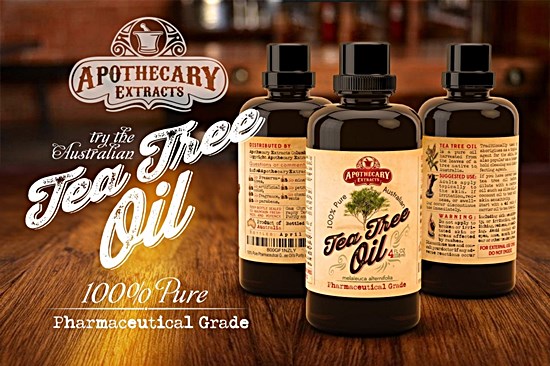
Is It Safe To Use?
Tea tree oil has an astringent medicinal scent, which is comparable to eucalyptus oil. If you like this kind of medicinal smell, you’ll like tea tree oil. If not, you might prefer one of the other oils below.
When applied to the skin neat, tea tree oil can sting or burn slightly. That’s why you use a carrier oil to dilute it so that it won’t hurt. You should feel a cool, tingling feeling when you apply it.
You must avoid taking any tea tree oil by mouth. Just because it is natural, that does not mean it is safe to ingest. It is highly toxic. Small doses will result in confusion and delirium. High doses can result in coma.
Is It Effective?
Tea tree oil for skin tags is by far the most effective of the oils on our list. It is a favorite of natural skin care specialists, and for a good reason. It dries out skin quickly and effectively, especially if you choose a pure oil.
Unfortunately, since tea tree oil is so popular, there are plenty of counterfeiters out there. If you notice that a certain brand of tea tree oil is cheaper than another, that doesn’t mean you’re getting a good deal. It means you’re getting sub-par oil that won’t get rid of your skin tags (or improve your complexion).
Check the Current Price of Apothecary Tea Tree oil on Amazon!
2) Frankincense Oil
Frankincense oil is famous for being one of the gifts of the Three Wise Men. Two thousand years later, it’s still in use. Frankincense is normally used as a kind of incense, which is where the name comes from Old French for ‘high-quality incense.’ It is the product of many different trees in the genus Boswellia.
True to its Biblical associations, the majority of frankincense is produced in Somalia, southern Arabia, and Ethiopia.
Traditional uses for frankincense include:
- As incense in the holy rites of several religions
- As an ingredient in different kinds of perfume
- As an ingredient in skin care products
Pure frankincense is a resin. Frankincense oil comes from a process called steam distillation. Frankincense oil is one of the better essential oils for removing skin tags and can work if used consistently.
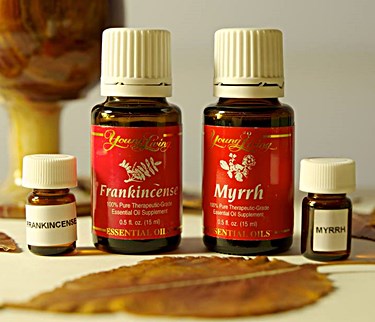
Is It Safe To Use?
Frankincense oil has a very pleasant smell. Overall, it has a woody and earthy smell, not too far from pine. It also has a slightly floral and fruity fragrance to it, which overall makes it very pleasant. You won’t mind applying it time and time again and doesn’t smell out of place as a masculine scent either.
Like other essential oils, it has the potential to irritate if applied neat. That being said, many people report that they can apply it even without a carrier oil. Even so, we would recommend performing a patch test either way. In some people, frankincense oil can cause rashes and even nausea and stomach pain. It may not be for you.
Is It Effective?
You will find plenty of people saying that frankincense oil works on skin tags because it is antiseptic or antifungal. While this is true of the oil, the idea that this helps it remove skin tags is categorically not. Skin tags are not caused by bacteria or by a fungal infection.
Some people report that frankincense oil works, whereas others report the opposite. Those for whom it does work report that after a month or so, their skin tag dries, crumbles and falls off. In terms of effectiveness, it is less effective than tea tree oil. However, it is more effective than the other oils on our list. If you are interested in trying frankincense oil, choose a high-quality brand.
Check the Current Price of Frankincense Oil on Amazon!
3) Oregano Oil
Oregano is a familiar ingredient from some of our favorite foods (particularly pizza). Even though their tastes are so wildly distinct, oregano is a relative of mint. It has been used by the people of Italy and other Mediterranean countries for centuries to flavor foods. If you’ve somehow never tried it, it has a pleasantly aromatic and bitter taste.
But did you know that oregano oil has been just as popular, for just as long? Oregano oil has the same scent as regular oregano. You can distill it using the same steam distillation method as frankincense. This means that the oil is nothing but the pure product of young oregano leaves.
Traditional methods of oregano and oregano oil include:
- As a flavoring for food across the world
- A folk remedy for gastrointestinal problems
- Herbal treatment for urinary tract disorders.
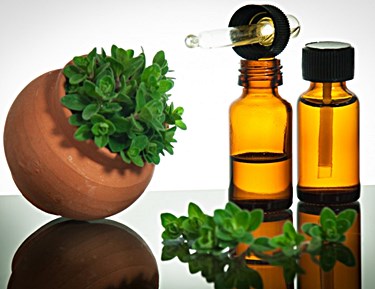
Is It Safe To Use?
This entirely depends on whether you like the smell of oregano or not. The smell is pleasant, and would not be out of place. Bear in mind that if you use it to treat your skin tags, you will smell like whichever oil you use quite strongly.
As we mentioned above, oregano is in the same family as mint. It is also in the same family as basil, marjoram, sage, and thyme. This means that if you have an allergy to any of these herbs, you will most likely also have an allergy to oregano. Besides being a potential allergen, oregano can also be an irritant. This is especially the case, as always, when you apply it neat to your skin.
Is It Effective?
Oregano oil for skin tags is reasonably effective. It is not quite as strong as tea tree oil. All you have to do is smell both oregano oil and tea tree oil to understand why! It works in the same way as other oils, drying up the skin tag, making it crumble. Not unlike other oils, it will take a long time to take effect.
Whether or not it is effective against skin tags, there is other information you should bear in mind. While oregano is a popular folk medicine, studies have not been able to prove its properties. Tea tree oil, for instance, is backed by genuine science. Whereas studies have proven that tea tree oil is antifungal and antibacterial, similar studies on oregano oil have found no such thing.
In fact, the USFDA has taken a hard line on the promotion of oregano oil. Multiple companies have been warned not to advertise oregano oil as an antibiotic. The USFDA is not always right, but at the very least, you should be aware of their position.
Check the Current Price of Oil of Oregano on Amazon!
4) Lemon Oil
Lemon oil needs no introduction. As you might have guessed, it comes from the zest and peel of lemons. Unlike other kinds of essential oil, it is not produced using steam distillation. Instead, manufacturers utilize ‘cold pressing’ or ‘expression’ techniques to collect the oil. In this method, the oil is quite literally squeezed out of the rind.
Lemon oil and lemon juice have many uses around the home.
Traditional uses of lemon oil and lemon juice include:
- As a neat liquid, lemon juice can be used to degrease surfaces
- Lemon juice is a natural anti-bacterial substance perfect for cleaning
- As an ingredient, lemon juice is a part of almost every household cleaning product
- Lemon oil, orange oil, and other citrus oils are natural insecticides
- Aromatherapists use lemon oil to help people relax
Lemon oil is primarily a cleaning agent. It is less familiar as an ingredient in skincare products. Even so, it is an essential oil that you could use on your skin tags.
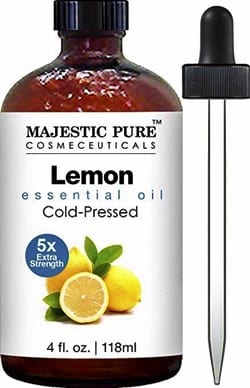
Is It Safe To Use?
Lemon oil is perhaps the most pleasant essential oil to use. The rich and vibrant smell of lemons is familiar to everybody, and won’t make you stand out. You will, therefore, have no problem using lemon oil for natural skin tag removal.
As always, lemon oil should be applied as part of a mixture with a carrier oil. Otherwise, your skin may become hypersensitive or irritated. In rare cases, lemon oil (and other citrus oils) can cause phototoxicity.
Phototoxicity is a chemically induced skin irritation: in other words, in addition to causing irritation, lemon oil can cause irritation which is exacerbated by exposure to sunlight. This can result in severe burns. It is therefore vital that you perform a patch test before using lemon oil.
Is It Effective?
Lemon juice is an effective skin tag treatment. Lemon juice is naturally acidic, and if you apply a natural (or non-natural) acid to a skin tag, it will eventually cauterize. However, lemon oil is neutral pH; it does not work by cauterizing your skin tags. Instead, it works like every other kind of essential oil, by drying out the area gradually.
Some people report that it works in a matter of just days. Others report that it takes weeks. It all seems to come down to some as yet undiscovered factor such as body chemistry whether it will work for you. We recommend that you try lemon oil if other methods (especially tea tree oil) fail.
However, you should not use lemon oil as a long-term solution for tackling skin tags. If your skin tag does not fall off quickly, using a lemon oil for the long term is a bad idea. It will irritate your skin, even in highly diluted applications.
Check the Current Price of Lemon Oil on Amazon!
5) Oil of Clove
Clove oil is less common than lemon oil and tea tree oil. In fact, you may never have encountered it before. It’s made from cloves, which have a strong spicy smell. Cloves are harvested from the clove tree, which is native to Indonesia, India, and Pakistan. Traders from the far East have dealt in cloves for hundreds of years.
Traditional uses of clove include:
- As a spice in food. Clove has a uniquely warm and spicy taste
- As a spice in drinks, like mulled wine
- As a traditional cure for a toothache
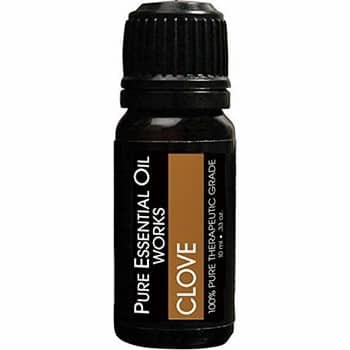
Is It Safe To Use?
The smell and taste of cloves is divisive: you either love them, or you hate them. Clove oil smells very strongly, which may put you off from using it. However, if you like the smell and taste of cloves, you won’t mind as much.
Clove oil is a well-known irritant and skin sensitizer, just like lemon oil. You will, therefore, have to dilute your oil mixture even more if you choose to use clove oil. If ingested, clove oil can cause toxic effects like tea tree oil. These effects include nausea and vomiting, difficulty breathing and even seizures.
Is It Effective?
Clove oil is second only to tea tree oil concerning effectiveness. It is exceptionally strong, which is why it has to be diluted so much. Despite its efficacy, however, little research has been done on the effects of clove oil. It is not as common as the other kinds of oil in this list, and so may also be a little more expensive.
Check the Current Price of Oil of Clove on Amazon!
How Long Does Removing Skin Tags with Essential Oil Take?
Removing skin tags with essential oil can take quite a long time. You have to consistently apply the essential oil every day, at least once or twice. If you miss a day of applying the oil, your progress may be reversed. Most people experience that it takes between a month and two months.
The problem is that everybody’s skin reacts differently to this method. If your skin is already quite dry, or your skin tag is small, it will take less time. It may take less than a month. If your skin is very well taken care of, or your skin tag is large, it may take longer. Or, it may be impossible to get rid of your skin tag altogether.
This is the drawback of this method since other ways of removing skin tags typically take less time. In our final section of this guide, for instance, we explore a few other ways you might remove your skin tag. Among them are excision, cryotherapy, legation, and cautery.
These methods take far less time than using essential oils. Excision, for instance, cuts off your skin tag immediately. Cautery and cryotherapy immediately destroy the tissue of your skin tag as well. If you are concerned about the time it might take to remove your skin tags using essential oils, see our list at the end of this guide.
Do I Need to Take Any Precautions?
Before you begin treating your skin tag with essential oils, there are a few precautions you should take. There is a limited risk that your skin might react to the essential oil. This is the case for all kinds of essential oil, even those which are marketed as natural and completely safe. Effects range from irritation to a full allergic reaction.
It is therefore vital that you follow these guidelines:
- You must dilute the essential oil with a ‘carrier oil’ before you apply it to your skin. Essential oils- depending on the kind that you buy- can be exceptionally strong. A carrier oil is a similar oily substance, but with a neutral effect on the skin. Examples include almond oil, avocado oil, and grapeseed oil.
- Once you have diluted your oil, you should then perform a patch test. This is where you take a small sample of the oil and apply it to a patch of your skin. Choose an area which is far from anywhere sensitive, and which you can hide with regular clothing. The skin on your forearm is an example. This ensures that the rest of your skin will not react negatively to the oil.
Wrap the area in a bandage once you have applied the oil, and leave it for at least a day. If your skin does not react negatively, you are all clear to treat your skin tags.
What Are The Drawbacks?
Essential oils are an excellent choice for many reasons. First, they are effective. Second, they are completely natural. Third, there are plenty to choose from if one doesn’t work for you. That being said, there are also some drawbacks. These may mean that alternative skin tag removal methods are better for you.
- Essential oils take far longer to work than other methods of skin tag removal.
- You may not find the smell of certain essential oils to be pleasant. Whether or not you like the smell, you will have to apply the oil multiple times per day. You will, therefore, smell of whichever oil you choose almost permanently for a month.
- Essential oils have a lower success rate than other methods. Using tea tree oil correctly will get rid of your skin tag 90% of the time. However, surgically removing your skin tag works 100% of the time.
How Else Can Skin Tags Be Removed from the Face and Body?
If essential oils aren’t to your taste, you’re in luck: there are plenty of alternatives on the market. Here are the main methods of skin tag removal which you might prefer.
1) Apple Cider Vinegar
Apple cider vinegar works in the same way as essential oils. It aims to dry out the skin when applied liberally and consistently. You may prefer the smell of apple cider vinegar, or already have some at home. If so, this may be a method you could consider. Not to mention, apple cider vinegar is even cheaper than essential oils.
2) Cryotherapy (Also Known as Freezing)
Cryotherapy is a conventional method of skin tag removal. It’s used by dermatologists across the country to freeze off skin tags (as are the other three methods below). It works by killing the tissue of the skin tag through exposure to intense cold. This is achieved by using a precisely controlled application of liquid nitrogen.
3) Cautery (Also Known as Burning)
Cautery is the medical term for burning or corrosion. You have two options when it comes to cautery: cautery creams or electrocauterization. Cautery creams, despite what you might think, are completely natural. They corrode your skin tag over the course of a few days. In electrocautery, you would use a ‘cautery pen’ to burn your skin tag.
4) Excision (Also Known as Cutting Off)
Excision is the most common way that a dermatologist or physician would choose to remove your skin tag. Quite simply, your dermatologist uses a blade or a specially curved scalpel to cut the growth off. This is difficult to do at home for two reasons. First, the wound typically bleeds quite a lot, which can be awkward. Second, you would need to anesthetize the area in some way.
5) Ligation (Also Known as Tying Off)
Last but not least, ligation is the oldest method on our list. You tie a thread or band around the skin tag to deprive it of oxygen. Over time, the tissue will die and drop off. This is fiddly and difficult to achieve unless you use a kit like the TagBand.
Depending on your taste, you may prefer these methods to using essential oils to get rid of skin tags. You may want to buy just one or two essential oils for skin growths. That way, you will have some in your cabinet for the next time you need it. Alternatively, some of the products for the methods described above can also be used multiple times. In the end, the choice is yours.
